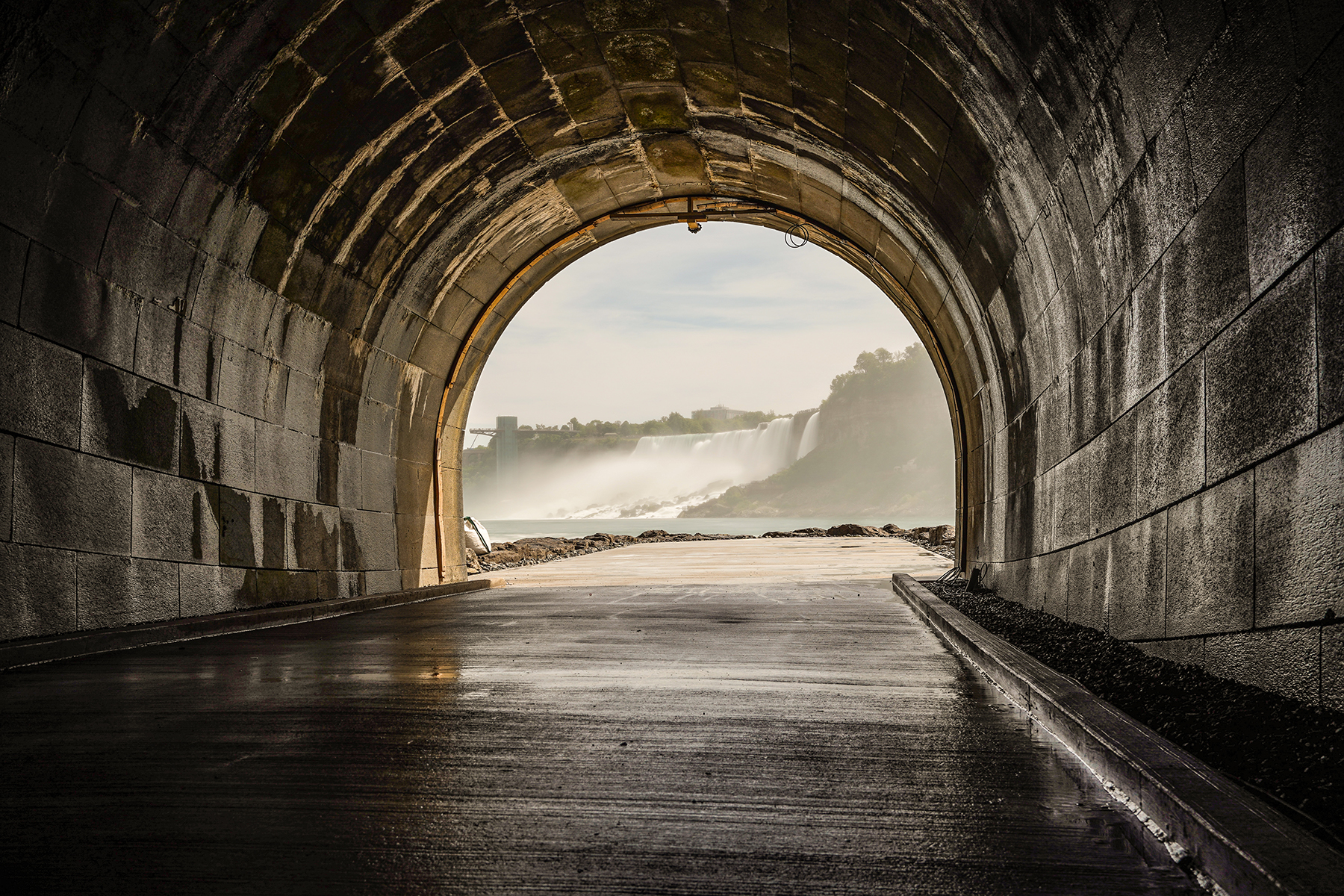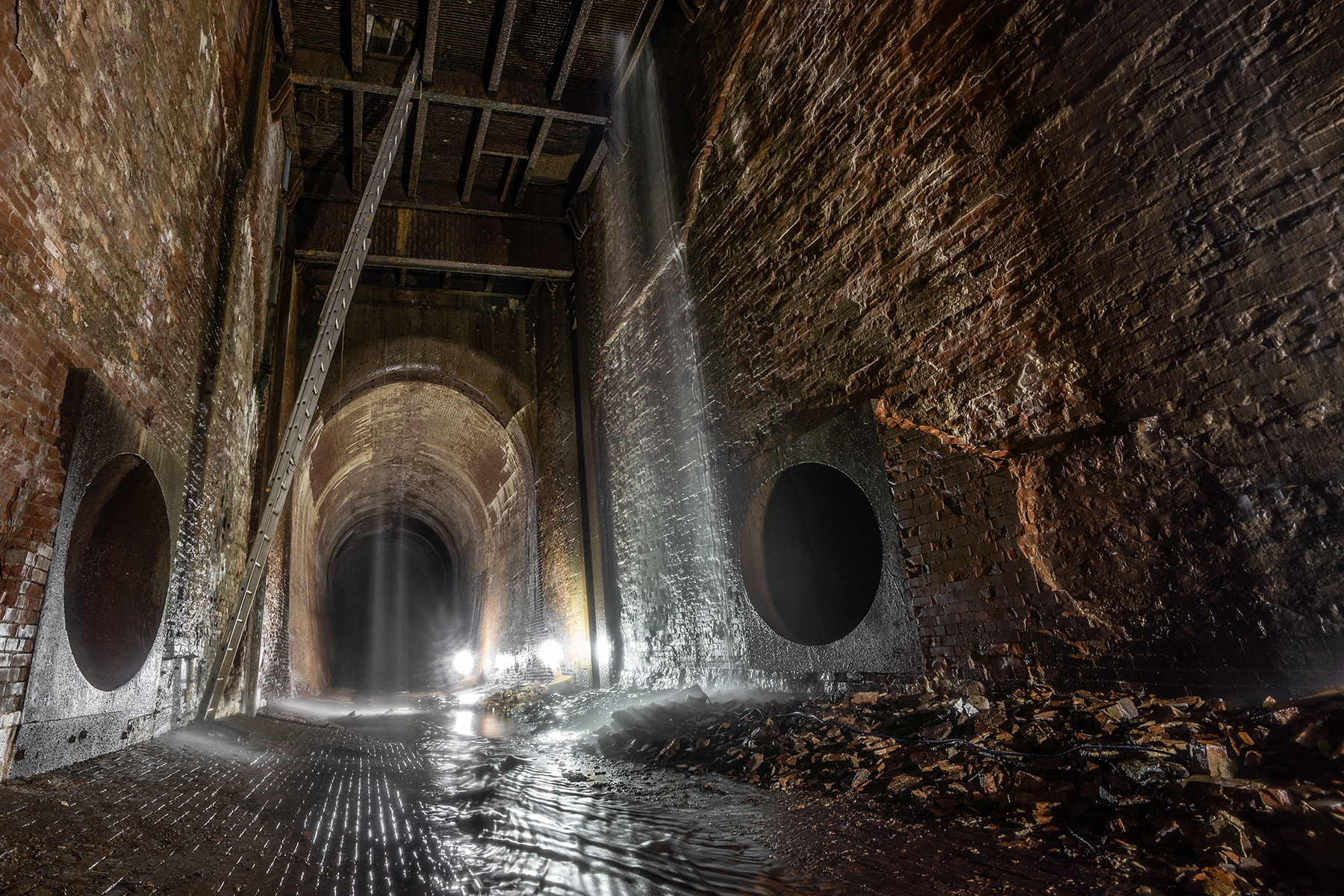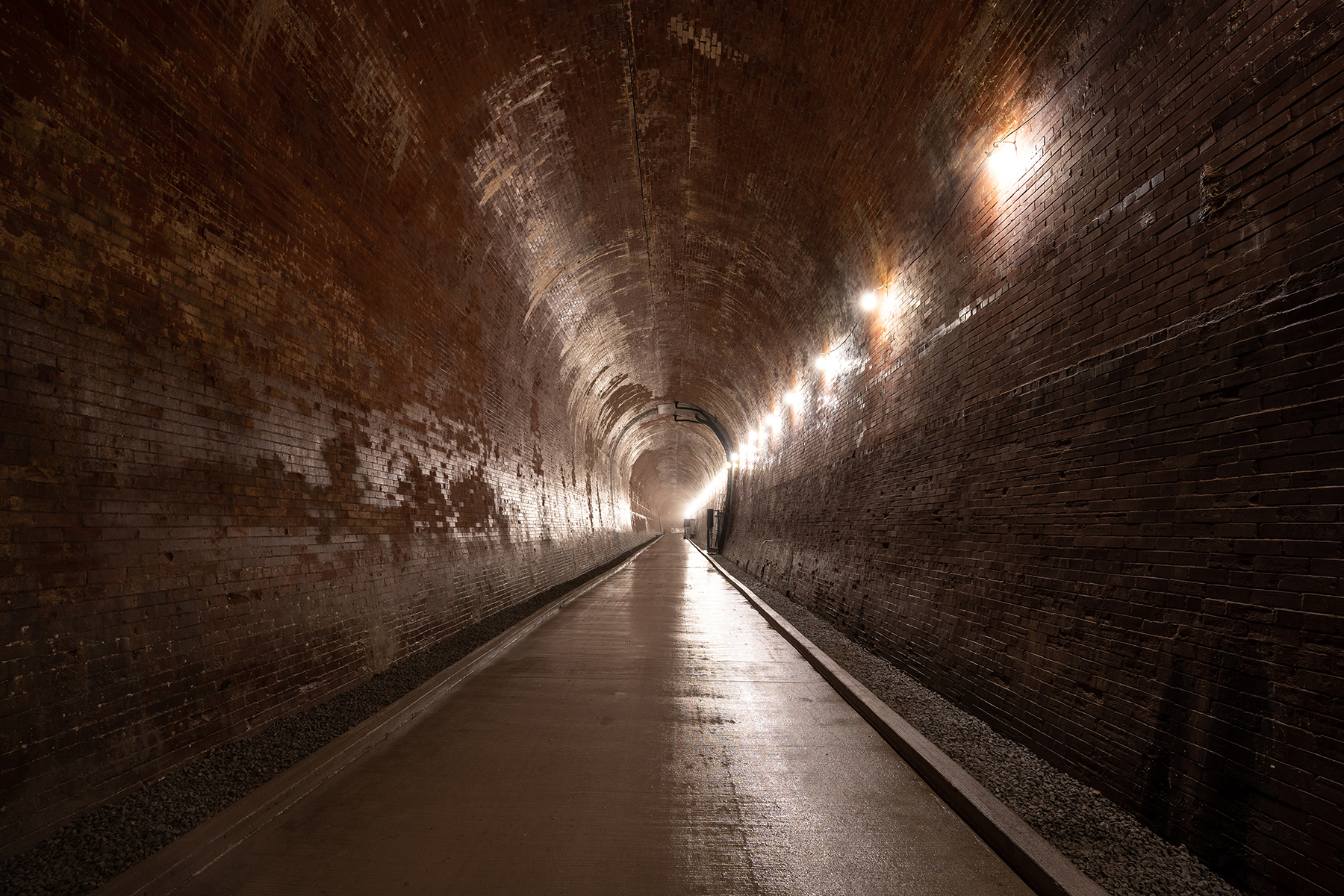By Leslie Nemo
It’s easy to see the energy potential in the Niagara River’s falls. The river acts as an international border between the United States and Canada, and across its most famous three waterfalls — collectively known as Niagara Falls — 3,160 tons of water cascade every second, hitting the pool below with something between 280 and 2,509 tons of force. And for 102 years, some of the power of the roaring natural feature made its way — via the Rankine Generating Station — into regional businesses as electricity. The generating facility was the first hydroelectric generating station on the Canadian side of the falls — an accomplishment that came about thanks to the many private businesses that tried to capture the power of the waterway for themselves.
Now, a tunnel that provided a route for power-generating water to return to the Niagara River has been refurbished to allow visitors to travel along its length as part of a new visitor center.

Starting in the mid-18th century, settlers in and around Niagara diverted slivers of the river to harness water power for profit. In 1759, an American named Daniel Joncairs made the first recorded employment of the water to turn a wheel for his sawmill. Almost half a century later, in 1805, two brothers bought the land Joncairs had once been on and then some in an auction offered by the state of New York. The pair used the Niagara to power a tannery and gristmill.
Within a couple decades, everything from paper mills to clothing factories lined the falls on the American side, and the first businesses dedicated to intrepid tourists began to show up on the Canadian side.
As time passed, the number of hotels and attractions grew. And this previously remote portion of the continent became more accessible in 1825 when the Erie Canal opened. Soon after, engineers finished the nearby Welland Canal, and in 1855, what was then the world’s longest suspension bridge started carrying train passengers through the area. The number of visitors grew from an estimated 13,000 to 15,000 a year in the 1830s to at least 30,000 by the middle of the century. As tourism boomed, the number of buildings lining the waterway skyrocketed, along with fences built to intentionally block views of the falls so that visitors would have to pay local entrepreneurs for a peek at the feature.
Making room for nature
The attractions and amenities clustered around Niagara Falls eventually became too much for a select group of Americans to handle. During an 1869 visit, conservationist and landscape architect Frederick Law Olmsted, federal lawyer William Dorsheimer, and architect Henry Hobson Richardson decided the infrastructure surrounding the falls had become overwhelming and started a campaign to have it removed.
Eventually known as the Free Niagara Movement, the push to turn the Canadian and U.S. sides of Niagara Falls into parks for everyone to enjoy attracted supporters like Ralph Waldo Emerson, Charles Darwin, and more.
Success came in 1883 when New York law called for the creation of what would be the first park in the state. In 1885, Ontario followed suit by creating the Queen Victoria Niagara Falls Park.
The two parks had similar intentions — to buy out the businesses on designated land and restore some of the previous landscape — but different tools. Namely, the Niagara Parks Commission overseeing the Ontario property was expected to be self-funded. The commission issued bonds to cover the costs of purchasing property. When it came time to generate revenue, the commission decided to sell the rights to the water rushing through the landscape.
In 1892, the park entered into an agreement with Canadian Niagara Power with the understanding that the company would produce 10,000 hp by 1897. The generator missed its deadline by eight years.
The extra time, however, gave the company founder William Birch Rankine and his engineering team a chance to learn from a similar facility on the American side of the falls that was then under construction.
The U.S.-based generator was the first major power-production effort that would spit out Nikola Tesla’s alternating current. Though the Rankine Generating Station was so far behind schedule that it drew local protests, that frustration might have ultimately been worth it, wrote Norman R. Ball for Hydro Review in 2005. “The delays gave the company and its investors what they needed most — time for rapidly changing electrical technology to mature.”
Besides adopting the same power output as the U.S. plant, ultimately the Rankine facility chose a similar generation style. A canal and forebay atop the falls would divert the river into gravity-fed penstocks, or giant tubes directed into the ground. The falling water would spin a turbine in a wheel pit before being returned to the river at the pool level via what is known as a tailrace tunnel.

Construction, which started in 1901, came with a series of demands. Ice sometimes floated from Lake Erie into the river and threatened to slow operations. The design team opted for an 8.5 ft tall steel rack to block larger ice chunks from the forebay, a finer “steel curtain” that could be lowered into the water if operators felt the need to sift out smaller fragments, and permanent vertical bars against the penstock mouths as a final defense against anything frozen.
The engineering and construction crew also chose to excavate the wheel pit and part of the tailrace tunnel simultaneously, one on top of the other. “This process was fairly successful until about two-thirds completed, when the blasting from above and below had so weakened and opened up the remaining shale that wheel pit water commenced to leak into the tunnel,” wrote Cecil B. Smith, the resident engineer for the Canadian Niagara Power in a 1905 paper describing the construction of the plant.
Out of concern for excessive loads bearing down on the tunnel, the crew problem-solved by timbering the tailrace roof and later supporting the wheel pit with cast-iron struts.
All 2,200 ft of the arcing tunnel, which sits 180 ft underground, was created via small dynamite blasts and manual digging. The excavation began by workers cutting a shaft into the ground halfway between the future wheel pit location and the intended outlet into the Niagara. Workers then dug in each direction, with those progressing toward the exit merging with a third crew that was excavating inward from the tunnel mouth.
The alignment of the two tunnel dig efforts toward each other was “almost perfect,” wrote Smith, due to guidance from “two piano wires 12 feet apart, suspended in the shaft” and the “extreme care in the use of plumbobs.”
The engineers weren’t sure what kind of friction the tunnel walls might experience. Lined with burnt brick and standing 25 ft high, the structure didn’t have well-tested predecessors carrying as much fast-moving water as the Rankine tunnel eventually would. Their confidence in the integrity of the design grew after an inspection of the equivalent tunnel on the American generator which, after seven years of use, was intact and had developed the ideal slimy surface the Rankine crew hoped would grow in their own tailrace.
The entire tunnel construction took about three years and wrapped up mere months before January 1905, when the Rankine Generating Station started operating.
A second life
Though the station stopped generating power in 2007, Niagara Parks has continued to maintain the structure. In 2017, the organization had to place concrete walls in front of the 11 steel headgates because they were deteriorating and letting water leak in. Once the facility was safely sealed up, a Niagara Parks team inspected the rest of the building. The crew cut through part of a maintenance shaft and installed swing stage scaffolding to get all the way to the tunnel, which they walked and inspected with geotechnical experts.
The brick-lined structure was in such good condition that the parks team started to wonder whether the tunnel and the main building could be opened to visitors. “It was definitely the trigger that we knew would bring people to the site,” says Marcelo Gruosso, the chief operating officer at Niagara Parks. “It’s just cool.”
With a $25 million loan from the Ontario Finance Authority, Niagara Parks moved forward on renovating the main building and tailrace tunnel to make them publicly accessible. For the latter structure, one of the biggest challenges was how tourists and construction teams would get to the underground location in the first place. Rankin Construction, an Ontario-based construction firm, was among the contractors that submitted proposals to the parks commission to turn the tunnel into a walkway. The group had installed the earlier swing stage that Gruosso and his colleagues rode, but at the time, the tunnel was too dark and wet to see much, says Rankin senior vice president Bill Snow, P.Eng.
The next opportunity for Rankin to see its potential work site was after the firm and its design partner, Ellis Engineering, understood they were the preferred bidders. A more thorough walk-through facilitated by the swing stage let the team determine it would be able to complete the requested work before signing the design-build agreement.
Making land
The inspection made it obvious that heavy equipment would have to get into the tunnel, even to remove the branches and debris that washed in over the years and accumulated into dams. But if the swing stage provided limited access, the exterior end of the tunnel had even less: The tunnel’s outlet dropped off at the rock face directly into the water. Rankin decided to build itself a work platform by placing clean rock fill in the river to create a landing pad at the mouth of the tunnel. A 300-ton crane, which the team stationed atop the adjacent gorge edge, then lowered equipment onto this platform. Skid steers, two excavators — an 8-ton and 30-ton version — steel baskets of supplies, and more made the 180 ft trip down to the tunnel mouth.
Making the tunnel visitor-friendly also required working around the ever-present moisture generated by the falls and river. Because of fissures in the walls, water is always leaking in. Also, the original building design funneled rain off the roof into the wheel pit so that all drainage produced power — a clever repurposing that meant rainwater was continually routed directly into the tunnel, Gruosso says. “We never thought we’d stop the water and make it a completely dry attraction.” Instead, the design team lifted visitors 5 ft off the floor of the tunnel and ran drainage pipes along with lighting, Wi-Fi, and cell cables, under a concrete walkway. Glass elevators now stopped on the new raised platform to transport visitors.

Building a concrete path running from the elevators to the mouth of the tunnel forced the construction team to find a way to pump material 2,200 ft. After coordinating with its supplier for a mix that would resist segregating and solidifying while being pushed that far, the team lowered a Pumpcrete trailer pump onto their staging area and worked from the back of the tunnel forward.
While the original contract called for the walkway to end at the tunnel’s mouth, the plans changed once people realized the view could be improved: Not much of the falls was visible to the south, Snow says. Building out a platform would give visitors a broader perspective. Crews extended the concrete walkway into a viewing area supported by the clean rock fill and armor stone, some of which was the material Ontario Power Generation had excavated while digging its own Niagara tunnel a few years earlier. (The electric company, which currently holds Niagara water rights, carved its tunnel so the river could flow into its downstream generating stations. Niagara Parks allowed the company to leave the excavated rock on parkland and then repurposed those boulders for its new viewing area.)
The moisture and constant water in the tunnel meant some crew members packed three to four changes of clothing each day in an attempt to stay dry — but the end of the project was particularly wet. “When you get out working in front of the tunnel and along the river edge, there's the mist from the falls,” Snow says. “It's like it's constantly raining down there.”
The main station building and the tailrace tunnel are now open to visitors. People learn the nuts and bolts of creating hydropower while walking through the ground-level facility, and the walk down the tailrace tunnel impresses people because of how much labor went into constructing a generator of this size at the turn of the century, Gruosso says. He and his colleagues learned even more about how the generator was put together as they analyzed write-ups, like the Smith report for the Canadian Society of Civil Engineers, and hundreds of photos the engineers and crews took during construction. “Either this was just good practice,” Gruosso says, “or they knew that they were leaving a legacy.”
The tunnel officially opened to visitors in July 2022.
This article first appeared in Civil Engineering Online.



